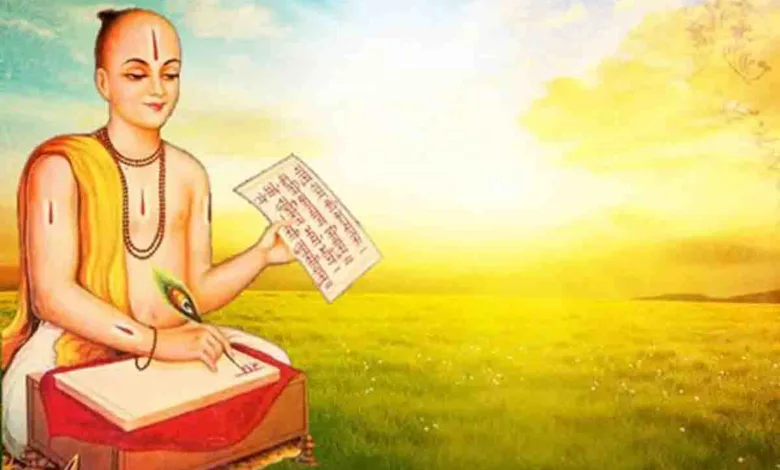Goswami Tulsi Das- the architect of Hindu resilience, identity & unity

GUEST COLUMN
 Vir Singh
Vir Singh
In the annals of Indian history, one name that stands out as a beacon of unwavering commitment to the preservation of Hindu identity and culture during the Mughal era is that of Goswami Tulsi Das. His magnum opus, the Ramcharitmanas, played a pivotal role in awakening Hindus and consolidating Hinduism in the face of Mughal dominance.
In the present day, as the Rama Mandir stands as a symbol of glory for Sanatana Dharma after enduring more than five centuries, the atmosphere resonating with triumphant shouts of “Jai Shri Rama” and the Indian sky adorned with saffron hues, it is crucial for joyous Indians to reflect upon and commemorate Goswami Tulsi Das. He played a pivotal role in establishing Rama in the hearts, minds and souls of Hindus worldwide.
Tulsi Das’ extraordinary contribution lies not only in the literary brilliance of his work but also in the resolute stance he took against the imposition of Mughal influence on the fabric of Indian society. Remarkably, Tulsi Das deliberately excluded any trace of the Mughal language or culture from his revered Ramcharitmanas. At a time when the Mughals sought to assert their dominance through linguistic and cultural assimilation, Tulsi Das stood as a bulwark, crafting a literary masterpiece that resonated deeply with the sentiments of the Hindu populace.
Goswami Tulsi Das wrote his epic Ramcharitmanas during the 16th century. He is believed to have composed this masterpiece between 1574 and 1576. The exact timeline may vary slightly according to different historical accounts, but his Ramcharitmanas remains a timeless and revered work in Hindu literature and undoubtedly the world’s most sung poetic epic.
One of the most striking aspects of Tulsi Das’ approach was his strategic omission of any Mughal elements from his poetry. The Ramcharitmanas, written in Awadhi, not only rejected the language of the imperial rulers but also steered clear of incorporating Mughal cultural nuances. This deliberate choice was a powerful statement of resistance against the cultural subjugation attempted by the Mughals. During a period when Indian rulers and Rajputs struggled to uproot the Mughal empire, Tulsi Das emerged as an unlikely hero. His Ramcharitmanas provided a unifying force for Hindus across the subcontinent. By presenting Lord Rama as the central figure and hero of his epic, Tulsi Das gave the Hindu community a common rallying point, inspiring them to unite against the oppressive rule of the Mughals.
The impact of Tulsi Das’ work went beyond the realms of literature. Ramacharitmanas, with its narrative centered around Lord Rama, became an eternal epic that transcended generations. It resonated in millions of Hindu households, serving as a source of inspiration, moral guidance, and a reminder of the enduring values of Sanatan civilisation.
The culmination of Tulsi Das’ influence is vividly seen in the contemporary resurgence of Rama’s worship and the establishment of the grand Ram temple in Ayodhya. The seeds of this cultural and spiritual revival can be traced back to the Ramcharitmanas. Tulsi Das laid the foundation for the reverence of Rama, culminating in the Pran Pratishtha of Ram Lalla in modern-day India. It would not be an exaggeration to refer to Goswami Tulsi Das as the “Father of the Nation” in the truest sense. His unwavering commitment to Hindu values, his defiance against cultural assimilation and the cultural rejuvenation he sparked through the Ramcharitmanas make him a towering figure in the history of Hinduism and the struggle against foreign domination.
Tulsi Das’ legacy endures as an indomitable force that shaped the course of Hindu history, contributing significantly to the eventual decline and extinction of the Mughal empire in India. His life’s work serves as a testament to the resilience of Hindu culture and the enduring power of literature in shaping the destiny of a nation.
Now when our Aditya L-1, launched by ISRO has reached near the Sun and is unfolding mysteries of it, we should link India’s unparallel cosmological feats with Tulsi’s Ramcharitmanas. Tulsi Das, in his Ramcharitmanas, provides a metaphorical and poetic description of the distance between the Earth and the Sun. In the Balakanda (Book of Childhood) of Ramcharitmanas, he compares the devotion and surrender of Lord Hanuman to Lord Rama to the immense distance between the Earth and the Sun. The verse in question is often cited from the Sundara Kanda, where Hanuman makes his first giant leap across the ocean to reach Lanka in search of Sita. Tulsi Das uses this occasion to express the extraordinary nature of Hanuman’s devotion. The verse roughly translates to:
Jab lagi avat tab lagahu utahi. Karahu paraspara pramana bhala bura na koi.
Sakha suta kehi nava sapadi gayavu. Kesari aja sulakhi sarira na soi.
This can be understood to mean that as long as Lord Rama’s avatar remains on Earth, Hanuman will continue to bridge the gap, much like the distance between the Earth and the Sun, without any obstacle or difficulty. The verse is a poetic device used by Tulsi Das to emphasise the boundless nature of Hanuman’s devotion and service to Lord Rama.
(The author is professor emeritus, Environmental Science, GB Pant University of Agriculture and Technology. Views expressed are personal)






